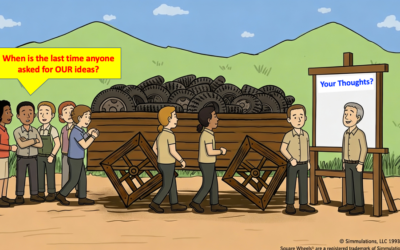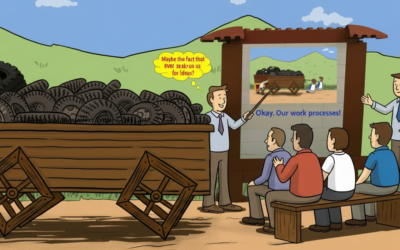The reality of change is that it takes new things to drive it forward. Innovation and employee engagement do not happen on their own unless the environment allows for it.
Change is a constant in the workplace: there is always something…
(And sometimes there are always too many somethings, causing burnout.)
Sometimes change appears to be happening too fast and sometimes it seems much too slow, given business needs. Sometimes we are looking to make changes and sometimes we simply must make change to keep moving forward. But not everyone, all the time, is looking for ideas about doing things differently, directly affecting innovation and engagement.
I created this image of how I think one way that reality intrudes on good ideas for change and improvement”

The reality of change is that managers often see themselves too busy to listen to new ideas, demotivating the people
Nothing is broken, so why change? The discomfort with the way things are is not sufficient to motivate the team to try something different. If nothing changes, understand that they will probably reach their goals.
Below, the simple idea is that the wagon wheel has broken, the team needs to get moving again, but a wheel needs to be replaced. With Round Wheels literally “at hand” and already in the wagon, we put on a new Square Wheel simply because that is what we have always done and the way things have always worked. We roll on Square Wheels!
My old “regular” line-art cartoons that I’ve used for years look like this:

Replacing a broken Square Wheel with a NEW Square Wheels seems to happen often, and no one sees Round Wheels or even the horse
The related image that shows some (possible) improvement looks like the one below. Has learning occurred? Yes, at least among some of the team. But does the team leader yet have a clue as to possibilities?

In this image, at least they are replacing a broken Square Wheel with a Round Wheel. Expect motivation to rise if the Round Wheel was an employee’s idea
Note also that nobody sees the horse, and probably not even you. Consider…
In the cartoons, overall, we see three people and some note the reluctance of the wagon puller to let go of the rope. Some viewers might comment that the guy at the far left is just lazy and not helping out. But you might also note that the wagon is up on the points of the Square Wheels, making it easier to install a new wheel but much harder to balance, which is the job of those two people.
One guy is lifting — we all know of those people who really put out the effort to help teams succeed.
Lastly. Many people simply miss the HORSE. The horse represents a completely different way to address the reality of moving the wagon. It is surprising how many people miss that aspect of the situation as they focus on the broken wheel. Heck, even the characters in the cartoon seem to have missed that!
What I have been doing for 20+ years is involving and engaging people to see things differently and teaching a VERY simple yet actionable model for understanding change, identifying leverage points and action plans and facilitating the process in such a way that the participants can identify things that they can do differently as well as engage others.
The key is to focus on employee engagement and ownership. If people are involved, they are more likely to be engaged and feel some sense of commitment to getting things done.
I use a simple tool, my Square Wheels illustrations and metaphor to set things up.
The wagon rolls on a set of wooden Square Wheels carrying a cargo of round rubber tires. The process continues this way because of a few different factors, such as the square wheels actually working (just like they always have), and the lack of perspective.
Learning Lesson: “Don’t just DO something, Stand There!”
The reality is that stopping the process and implementing improvement takes time and is not always successful. Plus, the round wheels of today will invariably become the Square Wheels of tomorrow.
The intent of this facilitation is to involve people in stepping back from the wagon and seeing the obvious – the round wheels already exist and should be implemented to make long-term progress and not simply to meet the goals for today.
Sometimes, I introduce the concept of Mud, the glop that gets in the way of moving forward. This can include organizational restraints (perceived and real), politics, culture or simply the difficulty in changing. I then show the wagon and the people up to their “axles” in this mess and how hard it is to make progress. For me, “mud” is a great metaphor and I use it with the theme, “Get out of the ditch and up on the road” to introduce the issue of choice and choices. We choose what we do.
(“Mud” can also be grinding paste, cement, and other things that make progress more difficult. Note also the silos ( clarity of missions and goals) and the Spectator Sheep, who could offer peer support if they would. Are they comfortable with the way things are? Hard to tell…)
If the above is your situation, deal with it. (“If it is to be, it is up to me!”)
“The best “Mud Managers” do things differently.
What is it they actually do and would those discussions be helpful?”
This is a great question to ask, since it generates alternative behaviors and alternative thinking in their discussions, often anchored on best practices of the exemplary performers in the room at that time. (Peer coaching!)
At some point in my design of organizational development workshops, we often move toward my simple and actionable model of change, involving the current level of discomfort with the way things are now, the attractiveness of the vision of the future, the individual or groups’ previous history with change and the peer support for improvement.
All four things are actionable and under control of the manager. Change can involve teamwork or simply group process techniques for identifying issues and opportunities. But once something (a process, generally) is anchored as a Square Wheel, it almost always generates an implementable round one — this nicely taps into the cognitive dissonance model of Festinger.
Change does not have to be done TO people and is best done WITH them, having them involved in the different aspects of environmental and social support. This is why the illustrations and the related discussions work, it is to get people actively involved to decrease the resistance to change and to generate some commitment to do something differently.
If you want to read more about this, you’ll find my new article that includes these ideas, “Teaching the Caterpillar to Fly” at:
My practical five-part article around this concept can be found here: https://performancemanagementcompanyblog.com/2013/07/02/teaching-the-caterpillar-to-fly-thoughts-on-change-part-one/
Plus, if you’d like to make any comment or discuss any of this, it would be most welcome. We can build a toolkit and training support for your supervisors to use with their people and support your use of the materials inexpensively and effectively,
For the FUN of It!
 Scott Simmerman Ph.D. CPF, CPT is still managing partner of PMC and collaborating with the team at PMC LLC, but also sort of retired and now loving living in Cuenca, Ecuador…
Scott Simmerman Ph.D. CPF, CPT is still managing partner of PMC and collaborating with the team at PMC LLC, but also sort of retired and now loving living in Cuenca, Ecuador…
Scott is developer of the incredible Square Wheels® tools and images
and the board game version of The Search for The Lost Dutchman’s Gold Mine
Scott has presented his concepts in 47 countries and collaborates with consultants and trainers worldwide.
You can reach him at scott@squarewheels.com and you can see his profile at LinkedIn
Square Wheels are a registered trademark of Performance Management Company











0 Comments